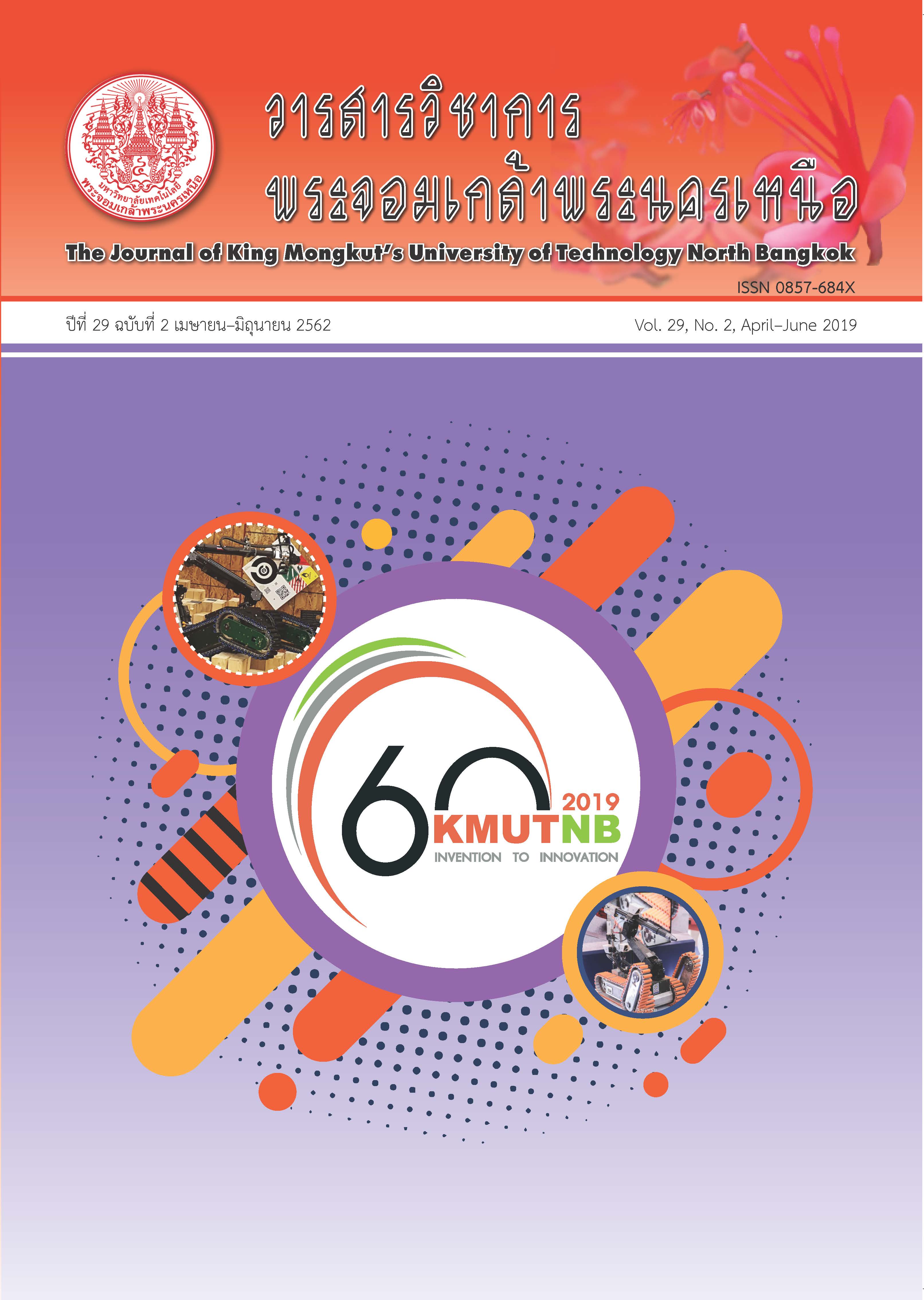สมบัติเชิงกลและการนำความร้อนของคอนกรีตบล็อกจากวัสดุเหลือทิ้งทางการเกษตร
Main Article Content
บทคัดย่อ
งานวิจัยนี้ศึกษาสมบัติเชิงกลและการนำความร้อนของคอนกรีตจากวัสดุเหลือทิ้งทางการเกษตร โดยอัตราส่วนระหว่างใบอ้อยและใบข้าวโพดผสมแตกต่างกันหลายอัตราส่วนผสมคงที่ระหว่าง ปูน : หิน : ทราย : น้ำ เท่ากับ 3 : 12 : 8 : 1.3 โดยน้ำหนัก โดยใช้อัตราส่วนใบอ้อยและใบข้าวโพดแทนที่ปูนซีเมนต์ร้อยละ 4, 6, 8, 10 โดยน้ำหนักของปูนซีเมนต์ โดยศึกษาสมบัติเชิงกลและการนำความร้อน ได้แก่ การทดสอบกำลังอัด ความหนาแน่น การดูดซึมน้ำ คลื่นอัลตราโซนิค และการนำความร้อน เป็นต้น ผลการศึกษาพบว่าอัตราส่วนใบอ้อยแทนที่ปูนซีเมนต์เท่ากับร้อยละ 4 โดยน้ำหนักของปูนซีเมนต์ เป็นอัตราส่วนที่ที่ใช้คุณสมบัติดังต่อไปนี้ลดลง ได้แก่ ค่าการนำความร้อน ความหนาแน่น และค่ากำลังรับแรงอัด และสมบัติที่เพิ่มขึ้นได้แก่ การดูดซึมน้ำ เป็นต้น ซึ่งจะให้สมบัติเชิงกลและการนำความร้อนดีกว่าอัตราส่วนแทนที่ปูนซีเมนต์ด้วยใบข้าวโพด สำหรับการทดสอบความเร็วคลื่นอัลตราโซนิคเพื่อทดสอบกำลังรับแรงอัดและความหนาแน่นเป็นปริมาณที่มีความสำคัญสำหรับกำหนดลักษณะสมบัติเชิงกลของคอนกรีตบล็อก การศึกษาค่าการนำความร้อนของคอนกรีตบล็อกผสมด้วยใบอ้อย และใบข้าวโพดแทนที่ปูนซีเมนต์สามารถลดการนำความร้อนเข้าสู่อาคารได้ถึง 53.29% และ 54.93% ตามลำดับ ซึ่งสามารถพัฒนาเป็นฉนวนกันความได้เป็นอย่างดีและยังเป็นวัสดุที่เป็นมิตรกับสิ่งแวดล้อมด้วย
Article Details
บทความที่ลงตีพิมพ์เป็นข้อคิดเห็นของผู้เขียนเท่านั้น
ผู้เขียนจะต้องเป็นผู้รับผิดชอบต่อผลทางกฎหมายใดๆ ที่อาจเกิดขึ้นจากบทความนั้น
เอกสารอ้างอิง
[2] S. Inthata and C. Khankham, “Use of rice straw to produce the insulation cement board,” Pawarun Agriculture Journal, vol. 12, no. 1, pp. 24–34, 2015.
[3] Office of Agricultural Economics, (2016, May), Potential of biomass in Thailand. MCOT. Bangkok, Thailand [Online]. Available: http://www.mcot.net/cfcustom/cache_page/164331.html.
[4] Land Development Department, (2018. October). Proper Cultivation in Thailand. ministry of agriculture and cooperatives. Bangkok, Thailand [Online] Available: http://www.ldd.go.th/NewsIndex/Zoning_Plant/index.htm.
[5] Royal Forest Department, Forest Research and Management Institute. Bangkok: Ministry of Natural Resources and Environment, 2007, pp. 21.
[6] Standard Test Method for Compressive Strength of Hydraulic Cement Mortars (Using 2-in. or [50-mm] Cube Specimens), ASTM C109/C109M-13, 2018.
[7] J. Tangpagasit, R. Cheerarot, C. Jaturapitakkul, and K. Kiattikomol, “Packing effect and pozzolanic reaction of fly ash in mortar,” Cement and Concrete Research, vol. 35, no. 6, pp. 1145–1151, 2005.
[8] G. A. Habeeb and M. M. Fayyadh, “Rice husk ash concrete: the effect of RHA average particle size on mechanical properties and drying shrinkage” Australian Journal of Basic and Applied Sciences, vol. 3, no.3, pp. 1616–1622, 2009.
[9] J. Khedari, B. Suttisonk, N. Pratinthong, and J. Hirunlabh, “New lightweight composite construction materials with low thermal conductivity,” Cement and Concrete Composites, vol. 23, no. 1, pp. 65–70, 2001.
[10] C. Asasutjarit, J. Hirunlabh, J. Khedari, S. Charoenvai, B. Zeghmati, and U. C. Shin, “Development of coconut coir-based lightweight cement board,” Construction and Building Materials, vol. 21, no. 2, pp. 277–288, 2007.
[11] C. Asasutjarit, S. Charoenvai, J. Hirunlabh, and J. Khedari, “Material and mechanical properties of pretreated coir-based green composites,” Composites Part B: Engineering, vol. 40, no. 7, pp. 633–637, 2009.

